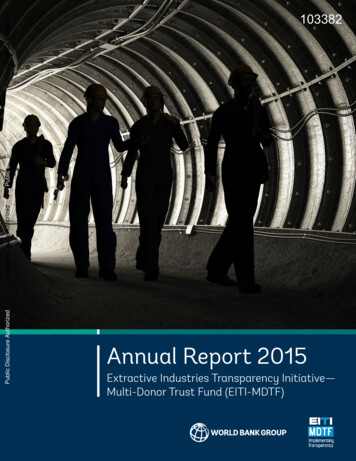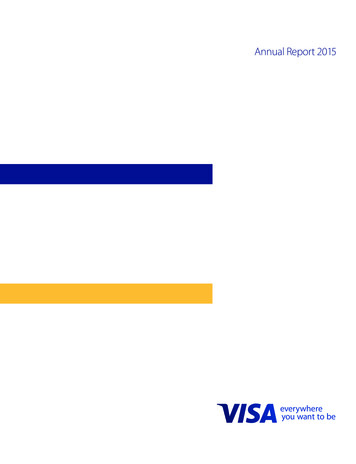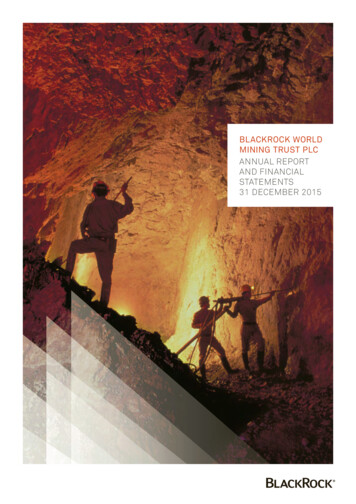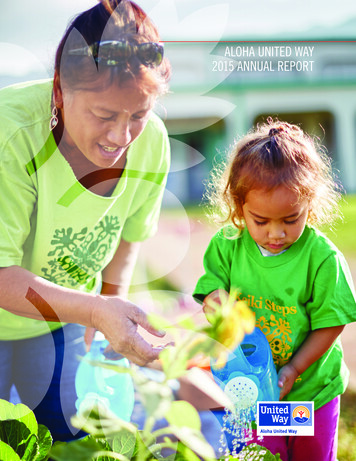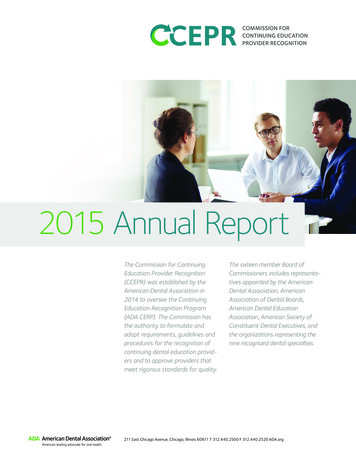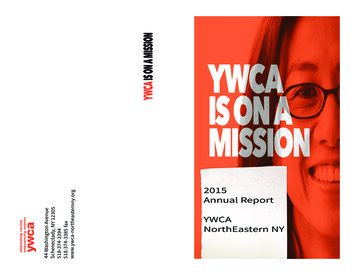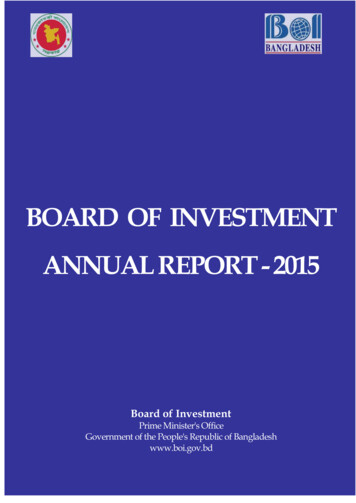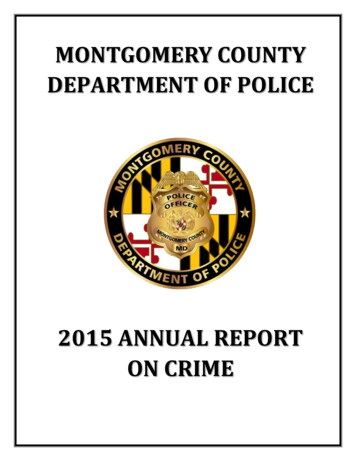
Transcription
MONTGOMERY COUNTYDEPARTMENT OF POLICE2015 ANNUAL REPORTON CRIME
Copyright 2016 by the Montgomery County Department of Police2015 MCP Annual Report on Crime compiled by Dr. Melissa Schulze (PhD), Policy & Planning DivisionGeospatial Analysis provided by Mr. Jason Enos, Information Management & Technology Division
A MESSAGE FROM THE CHIEFOver this past year, many residents have made MontgomeryCounty home, which has contributed to an increase inresidential and business development, traffic challenges, andcrime and public safety concerns. While these issuessometimes stretch the Department’s resources, we arenonetheless committed to being responsive to thecommunity’s needs.In 2015, officers were dispatched to over 225,000 calls toassist the community. Over these thousands of calls, officersinteracted with residents, businesses, and commuters toprovide the most professional police service during their timeof need. This Annual Report of Crime summarizes thoseinteractions that victims of crime had with officers in ourcommunity.While there was a slight increase in overall reported crime by1%, there was a significant reduction in more serious crimesknown as Part I offenses by 2.6%. The largest reduction in Part I offenses includes robberies, burglaries,and larcenies. This year, 30 people were victims of homicides—which is the highest since 2002. Onereason for this increase is that eight of the homicides were gang related, compared to one or two inprevious years. In a jurisdiction over 1 million people, this is a low number compared to other cities andcounties in the United States. However, no loss of life is acceptable in our community. Ourcomprehensive investigations closed all but two of these homicide cases. We will continue to follow newleads in an effort to bring closure to every homicide case that has occurred in Montgomery County. Youwill notice also that rapes showed a dramatic increase of 117.2%. This is attributed to the FBI’s newdefinition of rape and also due to administrative reporting changes that account for 89% of this increase.We explain the change in the definition of what is classified as a rape later in this report.In February 2015, Governor Hogan established the Maryland Heroin and Opioid Task Force to address agrowing concern of heroin-overdose deaths in the state. Montgomery County Police responded to over100 drug-related overdoses that resulted in 52 fatalities this year. In response to the growing number offatalities, selected patrol officers were equipped and trained on the administration of Naloxone to beused to save lives during a narcotic overdose.The Montgomery County Police Department will continue to provide the highest level of police service toprevent crime, improve traffic safety, and provide assistance to our community. I encourage everyone toreview the crime report for your police district and contact your District Commander, or me, with anyquestions or concerns.MONTGOMERY COUNTY DEPARTMENT OF POLICE1
2015 CALLS FOR SERVICECalls for service in Montgomery County have gradually increased 6.7% since 2011. In 2015, theMontgomery County Public Safety Communications Center (PSCC) received 895,9341 calls forservice, an increase of 8.8% over the number of calls received in 2014. Sixty-four percent of the callsreceived were emergency calls, an average of 1,580 per day and 4% higher than the number ofemergency calls received in 2014.The number of dispatched calls for service also increased in 2015, by 4%. Police officers weredispatched to 225,394 calls, of which almost 10% were priority calls, those which require twoofficers and an expedited response, generally using lights and sirens. The primary types of calls thatrequired a priority response in 2015 included domestic violence, personal injury collisions, assault,and burglary. Although there has been a decline in total dispatched calls for service since 2011, thenumber of emergency calls has increased slightly. This is a trend the department will continue tomonitor to ensure that response times are appropriate, and that life-safety is not compromised,either for the responding officers or the person waiting for the officers to arrive.Currently, performance metrics used by the PSCC, such as time to answer, time to dispatch, and totalresponse time continue to exceed industry standards. To learn more about these measures, visit theCountyStat program on the Montgomery County website.YEAR-END CRIME STATISTICS, 2014/2015 COMPARISONThe Montgomery County Police Department reports crime under the Federal Bureau ofInvestigation’s (FBI) Uniform Crime Reporting (UCR) program, which collects data in order tomeasure the level and scope of crime occurring throughout the nation. The Part I offenses includethose that are most serious: homicide, rape, robbery, aggravated assault, burglary, larceny, and autotheft. In 2015, Part I offenses in Montgomery County declined 2.6%2, despite increases in threeviolent crime categories.12Includes 141,220 calls that were transferred from MCP to MC Fire & Rescue Services.Crime statistics from the Montgomery County Police Records Management Dashboard as of January 20, 2016. Unfounded incidents are not included.MONTGOMERY COUNTY DEPARTMENT OF POLICE2
Part II offenses are generally less seriousand include the categories of simpleassault, disorderly conduct, driving undertheinfluence,drugoffenses,embezzlement, and more. There werenearly 1,000 more Part II offensesreported in 2015, a 3% increase. With theincrease in Part II offenses, the total crime(Part I and Part II) increased 1% in 2015.As a result of the overall increase, the crimerate per capita rose slightly to 5,057 crimesper every 100,000 people3.Since 2005, the population of MontgomeryCounty has increased by more than 13%, or120,000 people. Yet, the number of Part Ioffenses has decreased nearly 25% in thesame time frame, after spiking in 2008.This is a direct result of a more proactivepolice response to crime and public safety,and more dynamic investigative efforts, aswell as improvements in technology,advanced analytics, and state-of-the artforensics.The crime rate per capita for 2015 is based on population of Montgomery County in 2014 because the US Census Bureau had not yet updated the localpopulation numbers. It is more likely that the crime rate per capita has declined slightly.3MONTGOMERY COUNTY DEPARTMENT OF POLICE3
PART I OFFENSES: SUMMARY OF TRENDSDespite having an overall decline in Part I offenses, it is necessary to address increases in threecategories: homicide, rape, and aggravated assault.HOMICIDEIn 2015, Montgomery County recorded 30 homicides, which included an incident that occurred in2014, but was ruled a homicide in 2015. Thirty homicides are a significant increase from previousyears, and the highest number of homicides in Montgomery County since 2002, when the BeltwaySniper terrorized the region and there were 32 homicides. Over the last ten years, homicides haverisen 93%, but the per capita homicide rate continues to be extremely low, 2.9 homicides per100,000 people.The homicide detectives have closed all but two of these cases through their investigative work. Themajority of these homicides (73%) were domestic-related (spouses, parents, children) or involvedacquaintances who became involved in an interpersonal dispute that precipitated violence, which issimilar to prior years’ trends. This year, investigations determined that eight homicides were gangrelated, a considerable increase over previous years, although overall recorded gang activity hasdeclined.RAPEThe number of rapes recorded this year reflects a dramatic increase of 117.2%, or 278 rapes in 2015versus 128 in 2014. This includes 259 completed acts and 19 attempts. This increase can beattributed primarily to two administrative reporting factors:In 2015, the state of Maryland enacted the new definition of rape that was established by the FBI in2013. The FBI now defines rape as penetration, no matter how slight, of the vagina or anus with anybody part or object, or oral penetration by a sex organ of another person, without the consent of thevictim. This definition resulted in 74 additional rape classifications in 2015.In 2015, the police department also changed anadministrative report writing hierarchy rulerelated to counting certain offenses, whereby childabuse cases involving rape are now counted asrape, rather than child abuse. This was asignificant change and is most obvious when youlook at the number of rapes, the number of sexoffenses, and the number of child abuse cases, ashighlighted here.RAPESEX OFFENSE - SEXASSAULTFAMILY OFFENSE ABUSE/CHILD(sexual 018-85.0%34943424.4%These two factors alone account for 48% of all the reported rapes in Montgomery County, or 89% ofthe increase. Only six of all of the rape offenses were committed by a stranger; the rest werecommitted by someone known to the victim, such as a family member, neighbor, or friend of theMONTGOMERY COUNTY DEPARTMENT OF POLICE4
family. More than 30% of the victims refused to cooperate, despite the support offered to them.Rape is not an easy crime to detect or prevent, but the department has greatly increased its capacityto investigate these offenses by transferring investigative responsibility for all sex assaults andoffenses into one division, the Special Victims Investigation Division (SVID). The Montgomery CountyPolice Department also has an outstanding relationship with the Family Justice Center (FJC), the“one-stop shop” for victims of domestic violence. It is possible that this partnership may havecontributed to an increase in reported rapes, as the services offered at the FJC has encouraged morevictims to come forward and report this type of offense. Despite the increase in numbers, the SVIDremains committed to reducing the total number of rapes through non-traditional means, withservices offered to adult victims at the FJC and juvenile victims through the Department of Healthand Human Services’ programs, in coordination with Child Protective Services and Victim AssistanceSexual Assault Program (VASAP).AGGRAVATED ASSAULTThe number of aggravated assaults increased again in 2015, but the rate of growth appears to beslowing down. The trends in 2015 were similar to 2014: domestic-related assaults continue to be themost prevalent, accounting for 61.2% of all the aggravated assaults.OTHER PART I OFFENSESThefts from AutoUntil 2014, Montgomery County had been experiencing a consistent decline in the number oflarcenies reported, dating back to 2008, when there were more than 19,000 larcenies. In 2014, thenumber of larcenies spiked again, driven by a significant increase in the number of thefts from auto.By applying advanced crime analysis techniques, several of the districts were able to effectivelypredict which neighborhoods were being targeted and made numerous arrests, while several otherdistricts conducted outreach to educate the public on how to protect themselves from theft. The 2 ndand 3rd Districts were successful and reported a 12% and 2% decline in thefts from auto. However,MONTGOMERY COUNTY DEPARTMENT OF POLICE5
despite a general decline in larceny in 2015, the number of thefts from auto increased by 6.3%, andcurrently represents 41% of the total number of larcenies. Approximately 67% of the thefts fromauto occur when the vehicle is left unlocked.Auto TheftsFor the first time in ten years, Montgomery County saw a slight increase (4.9%) in the number ofauto thefts, from 794 in 2014 to 833 in 2015.MONTGOMERY COUNTY DEPARTMENT OF POLICE6
Districts 2, 4, and 6 represent 55% of all the stolen vehicles in the county and experienced significantincreases in auto thefts (35.5%, 14.3%, and 33.3%, respectively), while the incidents in the otherthree districts continued to decline.BurglaryThe number of burglaries in Montgomery County has been declining for many years. Thirty yearsago, there were more than 5,100 burglaries reported. Five years ago, more than 3,000 burglariesoccurred in Montgomery County. In 2015, there were less than 2,500 burglaries, almost 500 fewerincidents than 2014, a 20% reduction.PART II OFFENSES & OTHER TRENDSPart II OffensesThe increase in Part II offenses may be explained primarily by looking specifically at the increases inminor assault, juvenile runaways, and the category All Other Part II Criminal Offenses. These threeoffense categories alone accounted for a 9.6% increase in Part II offenses. Similar to the aggravated assaults, 42.2% of the minor assaults (includes assault and batteryand simple assault) occurred between spouses, partners, or other domestic relationship(family members).MONTGOMERY COUNTY DEPARTMENT OF POLICE7
There were approximately 100 more juvenile runaways reported in 2015 than in 2014. The category of All Other Part II Criminal Offenses records police activity for incidents such asforgery, bad checks, embezzlement, sex offenses, prostitution, and suicide, among others.Analysis of this category reveals that there were several factors, but no defined trends thatcaused the overall 7.5% increase (approximately 500 incidents) in this category: Credit Card Forgery increased 12.2% (790 v 886) Prostitution offenses increased 114% (50 v 107) Trespassing increased 37% (470 v 644) Harassment/Stalking increased 29.2% (120 v 155) Violation of ExParte/Protective Orders increased 25.3% (159 v 198) Sex Offenses increased 20.7% (356 v 430)WeaponsBecause there were more homicides committed by firearms this year than in previous years, mediacoverage suggested that firearms offenses were beginning to increase. Analysis of firearms-relatedoffenses, including homicide, aggravated assault, robbery, and Part II weapons offenses reveal that isnot the case. In 2015, violent offenses involving firearms and other firearms offenses (possession,discharge, concealment) were 4% lower than in 2014.The Firearms Investigation Unit (FIU) within the Special Investigations Division was called out 149times in 2015 for gun investigations; this unit handled more than 561 total cases in 2015 andrecovered 40% of the firearms seized by the Montgomery County Police. Overall, the FIU reported13.6% fewer guns recovered in 2015 than in 2014.MONTGOMERY COUNTY DEPARTMENT OF POLICE8
Controlled Dangerous SubstancesAs a whole, offenses involving controlled dangerous substances (CDS) declined slightly in 2015, dueprimarily to fewer charges related to marijuana. However, there were notable increases in severalcategories:20142015%ChangeCDS-SELL-OPIUM 8611938.4%CDS-POSS- OPIUM &DERIVATIVES17520718.3%CDS-POSS COCAINE&DERIVATIVES18720710.7%CDS-POSS AMPHETAM376062.2%OffenseOver the last few years, the number of opioid-related deaths has risen significantly throughoutMaryland, and Montgomery County has also felt the impact of this epidemic. Since 2013, the policedepartment has responded to 204 heroin overdoses,4 of which 60 were fatal. MCP responded to 73heroin overdoses in 2015 alone, 21 of which were fatal, and an additional 31 fatal overdoses causedby other drugs.The department has implementedinitiatives involving treatment (Naloxoneprogram), education, and enforcement toaddress this overdose epidemic.Chief Manger talks to officers duringtraining on the Maryland OverdoseResponse Program.4Heroin overdose statistics do not include fentanyl.MONTGOMERY COUNTY DEPARTMENT OF POLICE9
WHAT’S HAPPENING ON THE ROADS?In 2015, the Montgomery County Police conducted 130,342 traffic stops, which resulted in 235,310enforcement actions5 (warning, citation, or state equipment repair order (SERO)). Despite numerousenforcement initiatives to improve the safety of the travelling public, the Collision ReconstructionUnit responded to 38 fatal collisions which resulted in 39 total deaths. The number of fatal collisionsrepresents a 15.1% increase over the 33 collisions in 2014 that took the lives of 37 people. Prior to2015, the annual average of fatal collisions was 33.6, so it is disappointing to have such an increase.Thirteen of the 38 collisions involved pedestrians, six involved a motorcycle, and three involved abicycle.Most notably, 27 of the 38 (71%) collisions in 2015 were single vehicle collisions in which someonewas distracted, lost control, and/or struck a pedestrian, bicycle, or other non-motorized object.Sixteen involved a pedestrian or bicycle; 11 involved some other object. These were preventablecrashes that should not have occurred.5Data recorded by the state’s Electronic Traffic Information Exchange (E-Tix). Reference CAS# 16-094 (internal).MONTGOMERY COUNTY DEPARTMENT OF POLICE10
In 2015, the state released the Maryland State Highway Strategic Plan, which describes the ultimatetraffic safety goal: zero deaths. To become more proactive, the Montgomery County Police havestarted developing a data-driven approach to traffic enforcement, utilizing the state’s AutomatedCrash Reporting System (ACRS) and Electronic Information Exchange (ETIX) to access real time data.The MCP specifically emphasized pedestrian safety and distracted and impaired driving enforcementefforts in 2015. The district commanders each identified pedestrian enforcement hot spots based on crashdata, and most districts exceeded expectations conducting details around those hot spots,educating pedestrians and preventing more deadly crashes. The MCP received national recognition when officers in the 2nd District posed as a homelessman in order to spot drivers talking on their cellphones, in order to bring awareness to thedangers of distracted driving. In 2015, 25 Montgomery County police officers were struck by drunk drivers, either whilethey were on patrol or while conducting other traffic stops. In December, Police Officer NoahLeotta was struck and killed by a drunk driver as he investigated another suspected drunkdriver on a traffic stop. Officer Leotta was serving as a member of the annual Holiday AlcoholTask Force, a partnership between the MCP, Maryland State Police, Gaithersburg City Police,Takoma Park Police, and Montgomery County Sheriff’s Office, which focuses on enforcementof traffic laws in areas known for a high number of alcohol-related crashes, with the goal ofremoving impaired drivers from the road. Between November 2015 and January 2016, theHoliday Task Force members conducted more than 3,100 stops, found more than 6,400violations, arrested 371 impaired drivers, and issued numerous other citations for alcohol,CDS, and underage parties.At the beginning of 2016, the Montgomery County Council adopted a Vision Zero action plan, aninitiative that combines legislative action, police enforcement, and public education as a way to endtraffic-related deaths. The Montgomery County Police plan to continue to give high priority to thosestrategies that will reduce roadway fatalities and serious injuries, specifically as it relates toaggressive, distracted, and impaired driving, occupant protection, and pedestrians and bicyclists.As the Montgomery County Police and other public safety agencies work hard tokeep you safe, please remember to slow down and move over when you see anyemergency vehicles on the shoulder. That is the LAW in Maryland.MONTGOMERY COUNTY DEPARTMENT OF POLICE11
DISTRICT ANALYSISThe Montgomery County Police Department provides patrol services from six district stations:Rockville (1D), Bethesda (2D), Silver Spring (3D), Wheaton (4D), Germantown (5D), andGaithersburg (6D). Each of the districts varies significantly in size, density, and demographics, andeach faces its own challenges with preventing and reducing crime. Geographic and demographicfactors specific to each district must be considered comprehensively, in order to make an accurateand complete assessment of crime in that area. The districts, in general, reflected the overall trend ofvio
The Montgomery County Police Department reports crime under the Federal Bureau of Investigation’s (FBI) Uniform Crime Reporting (UCR) program, which collects data in order to measure the level and scope of crime occurring throughout the nation. The Part I offenses include those that
